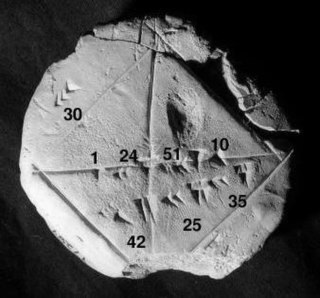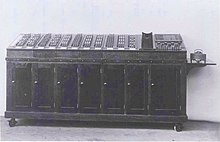
The Atanasoff–Berry computer (ABC) was the first automatic electronic digital computer. The device was limited by the technology of the day. The ABC's priority is debated among historians of computer technology, because it was neither programmable, nor Turing-complete. Conventionally, the ABC would be considered the first electronic ALU – which is integrated into every modern processor's design.

An analog computer or analogue computer is a type of computation machine (computer) that uses physical phenomena such as electrical, mechanical, or hydraulic quantities behaving according to the mathematical principles in question to model the problem being solved. In contrast, digital computers represent varying quantities symbolically and by discrete values of both time and amplitude.

Numerical analysis is the study of algorithms that use numerical approximation for the problems of mathematical analysis. It is the study of numerical methods that attempt to find approximate solutions of problems rather than the exact ones. Numerical analysis finds application in all fields of engineering and the physical sciences, and in the 21st century also the life and social sciences like economics, medicine, business and even the arts. Current growth in computing power has enabled the use of more complex numerical analysis, providing detailed and realistic mathematical models in science and engineering. Examples of numerical analysis include: ordinary differential equations as found in celestial mechanics, numerical linear algebra in data analysis, and stochastic differential equations and Markov chains for simulating living cells in medicine and biology.

The history of computing is longer than the history of computing hardware and modern computing technology and includes the history of methods intended for pen and paper or for chalk and slate, with or without the aid of tables.

Sir Maurice Vincent Wilkes was an English computer scientist who designed and helped build the Electronic Delay Storage Automatic Calculator (EDSAC), one of the earliest stored program computers, and who invented microprogramming, a method for using stored-program logic to operate the control unit of a central processing unit's circuits. At the time of his death, Wilkes was an Emeritus Professor at the University of Cambridge.

The differential analyser is a mechanical analogue computer designed to solve differential equations by integration, using wheel-and-disc mechanisms to perform the integration. It was one of the first advanced computing devices to be used operationally. The original machines could not add, but then it was noticed that if the two wheels of a rear differential are turned, the drive shaft will compute the average of the left and right wheels. Addition and subtraction are then achieved by using a simple gear ratio of 1:2; the gear ratio provides multiplication by two, and multiplying the average of two values by two gives their sum. Multiplication is just a special case of integration, namely integrating a constant function.
Computational science, also known as scientific computing, technical computing or scientific computation (SC), is a division of science, and more specifically the Computer Sciences, which uses advanced computing capabilities to understand and solve complex physical problems. While this discussion typically extenuates into Visual Computation, this research field of study will typically include the following research categorizations.

Douglas Rayner Hartree was an English mathematician and physicist most famous for the development of numerical analysis and its application to the Hartree–Fock equations of atomic physics and the construction of a differential analyser using Meccano.
In physics and mathematics, an ansatz is an educated guess or an additional assumption made to help solve a problem, and which may later be verified to be part of the solution by its results.
In mathematics a radial basis function (RBF) is a real-valued function whose value depends only on the distance between the input and some fixed point, either the origin, so that , or some other fixed point , called a center, so that . Any function that satisfies the property is a radial function. The distance is usually Euclidean distance, although other metrics are sometimes used. They are often used as a collection which forms a basis for some function space of interest, hence the name.
Optical computing or photonic computing uses light waves produced by lasers or incoherent sources for data processing, data storage or data communication for computing. For decades, photons have shown promise to enable a higher bandwidth than the electrons used in conventional computers.

Computational electromagnetics (CEM), computational electrodynamics or electromagnetic modeling is the process of modeling the interaction of electromagnetic fields with physical objects and the environment using computers.
Differential equations, in particular Euler equations, rose in prominence during World War II in calculating the accurate trajectory of ballistics, both rocket-propelled and gun or cannon type projectiles. Originally, mathematicians used the simpler calculus of earlier centuries to determine velocity, thrust, elevation, curve, distance, and other parameters.
The Oslo Analyzer was a mechanical analog differential analyzer, a type of computer, built in Norway from 1938 to 1942. It was the largest computer of its kind in the world when completed.
The following is a timeline of scientific computing, also known as computational science.
The following is a timeline of numerical analysis after 1945, and deals with developments after the invention of the modern electronic computer, which began during Second World War. For a fuller history of the subject before this period, see timeline and history of mathematics.
The Harrow–Hassidim–Lloyd algorithm or HHL algorithm is a quantum algorithm for numerically solving a system of linear equations, designed by Aram Harrow, Avinatan Hassidim, and Seth Lloyd. The algorithm estimates the result of a scalar measurement on the solution vector to a given linear system of equations.

Physics-informed neural networks (PINNs), also referred to as Theory-Trained Neural Networks (TTNs), are a type of universal function approximators that can embed the knowledge of any physical laws that govern a given data-set in the learning process, and can be described by partial differential equations (PDEs). They overcome the low data availability of some biological and engineering systems that makes most state-of-the-art machine learning techniques lack robustness, rendering them ineffective in these scenarios. The prior knowledge of general physical laws acts in the training of neural networks (NNs) as a regularization agent that limits the space of admissible solutions, increasing the correctness of the function approximation. This way, embedding this prior information into a neural network results in enhancing the information content of the available data, facilitating the learning algorithm to capture the right solution and to generalize well even with a low amount of training examples.
Probabilistic numerics is an active field of study at the intersection of applied mathematics, statistics, and machine learning centering on the concept of uncertainty in computation. In probabilistic numerics, tasks in numerical analysis such as finding numerical solutions for integration, linear algebra, optimization and simulation and differential equations are seen as problems of statistical, probabilistic, or Bayesian inference.









